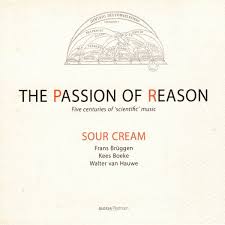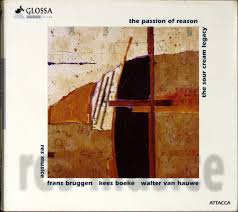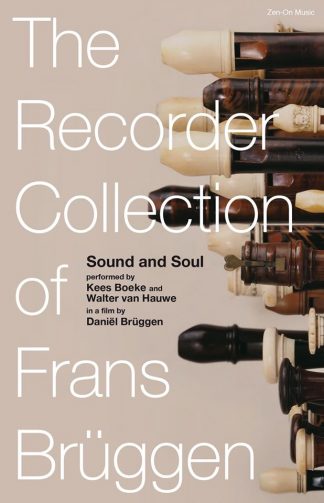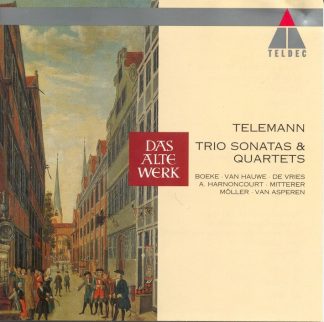Description
+Sour Cream, Isabel Alvarez-soprano, Toyohiko Satoh-lute
A Sour Cream Legacy
Program notes
GUILLAUME DE MACHAULT CD 1)
1 : Ma fin est mon commencement
Ma fin est mon commencement
et mon commencement ma fin
et teneure vraiement.
Ma fin est mon commencement
Mes tiers chans trois fois seulement
se retrograde et einsi fin.
The formal setup of this Rondeau could be expressed schematically as follows:
A B
12345 67890 cantus
90876 54321 tenor
abcde edbca contratenor
The Rondeau-form as such sounds
AB AA AB AB
2: Hoquetus David
Isorhythmic tenor: Versus Alleluia in Nativitate BMV die 8 septembris: Solemnitas gloriosae Virginis Mariae, ex semine Abrahae, ortae de tribu Iuda, clara ex stirpe DAVID. (Grad.Rom. p.598)
8 periods (talea) of 11 tactus (4+1 rest, 5+1 rest) presenting tenor DAVID (color) 3 times . 4 periods of 9 tactus (8+1) presenting tenor once.
3: Ballade 17 : Sanz cuer m’en vois
Polytextual ballade with voices A, B & C singing in canon in the unison. Three texts: A and C sung by the lover, B by the lady.
Refrain A & C: en lieu dou cuer, dame, qui vous demeure.
Refrain B: en lieu dou cuer, amis, qui me demeure.
Only one strophe is performed here, of three.
—————————————————————————————
SOLAGE
4 : Fumeux, Fume par Fumee
(Chantilly, Musée Condé Ms. 564)
The text of this famous Ars Subtilior Rondeau reads:
Fumeux fume par fumee:
Fumeuse speculacion:
Qu’autre fum(e) met sa pensee;
Fumeux fume par fumee.
Quar fumer moult li agree;
Tant qu’il ait son entencion;
Fumeux fume par fumee.
The reference is to a group of ostentatiously dressed Bohemians, maybe a sort of artistic-intellectual Parisian in-crowd, who named themselves after a certain Jean Fumeux. The wild chromaticism and harmonic language of the piece strongly underline the speculative character of this music, if not its text! In how far actual smoke was involved in their activities will probably remain a mystery forever.
A more realistic approach to the Fumeux enigma might be found in the medieval connection between alchemy and music as described in an essay by Bruno Cerchio (Il suono filosofale, LIM, Lucca 1993).
He points at the semantic chain that unites the Greek thumos (smoke) with the Latin fumus, the related verbs are in Greek theuin (to let smoke i.e. sacrifice), whereas the Latin fumus connects with fuere (to infuriate, to get inspired i.e. be under the influence of the fumi), and from there furor, inspiration. The symbolic relationship between smoke and spirit is clear, as is further corroborated e.g. in the painting ‘Le concert dans l’oeuf’ by Jeroen Bosch, where we see a character (the magister alchemist) wearing an upside-down funnel on his head from which a little smoke escapes. A well noted table from Henricus Kunrath’s Amphitheatrum sapientiae aeternae shows an incensor from which a smoke-cloud rises with the inscription: Ascendat ut fumus oratio sacrificium Deo acceptabile (may the prayer rise like smoke and be a sacrifice acceptable by God).
ANTOINE BRUMEL
5: Tandernack
Tandernaken al op den Rijn daer vant ic twee maechdekens spelen gaen…
3-part versions of this piece exist also by Obrecht, Lapicide and Alexander Agricola (all in the Odhecathon collection, 1501). The “tenor” in the middle part is of unknown origin.
THOMAS PRESTON
6: Upon La Mi Re
The La Mi Re formula is presented as an ostinato canon in the fifth upon which the superius invents an impressive cantilena rich in false relations typical of English music of the period.
The (anonymous) piece is found in a section devoted entirely to organ compositions by Preston in the British Museum Ms Add 29996.
—————————————————————————————
WILLIAM CORNYSH
7: Fa La Sol
8:Catholicon a
9:Catholicon b
Cornysh was a composer, poet, dramatist and actor in the service of both King Henry VII and VIII. The compositions presented here are both from King Henry VIII’s Song book (BM Ms. Add. 31992). He is represented also with various compositions in the Fairfax Ms. (BM Add. 5465). On 29 September 1509 Cornysh became Master of the Children of the Chapel Royal in succession to William Newark. In modern absolute notation the solmization syllables Fa La Sol can signify several combinations of notes i.e. F, A, G or B flat, A, G, or F, E, D or C, A, G etc. according to modal interpretation. Three-note motifs constructed with these sillables in any order or inversion form the basic material of the homonymous piece, much like Isaac’s La Mi La Sol which immediately precedes it in the Ms.
A “Catholicon” denominates a composition where modal interpretation applies to the piece as such. Notated in the “impossible” key of B natural (the progression V-I constitutes a tritone!), one can add three flats according to the rules of musica ficta to avoid “forbidden” intervals, creating a sort of mixolydian mode on E flat. (Un)fortunately the “impossible” version sounds equally good, if not better, in its hypophrygian key! Moreover, the tenor line is constructed like a palindrome, pivoting at bars 10, 15, 21, 24, and 28.
—————————————————————————————
ROBERT FAYRFAX
10 : That was my woe (Fairfax Ms)
That was my woe is now my most gladness;
That was my pain is now my joyous chance;
That was my fear is now my sikerness;
That was my grief is now my allegiance;
Thus has now grace enriched my pleasance,
Wherefore I am and shall be till I die,
Your true servant with thought, heart and body.
An almost exact contemporary of William Cornysh the two men were almost certainly both present at the funeral of Henry VII (9 May 1509), the coronation of Henry VIII (24 June 1509) and the Field of the Cloth of Gold (June 1520). This song survived in the so-called Fairfax Ms.
Noteworthy is the “recitation” in the second part of the poem on the Phrygian semitone E-F (Cf. TYE, Sit Fast and ISAAC, Se dormiero).
Compositions from the Baldwin Ms: tracks 11 (CD1) till 4 (CD2):
CHRISTOPHER TYE
11: Sit Fast
(Baldwin Ms. BM R.M. 24.d.2.fol.113v-115)
Threefold repetition of melody fragments, very similar to those used by Preston in Upon La Mi Re, characterize the superius in most of the Prima Pars and the second half of the Secunda Pars (Trinity symbolism?) The title of this monumental composition is explained by a postscript:
Singe ye trew & care not;
for I am trew feare not.
Similar poetic indications are given for two anonymous Salva Nos settings immediately preceding GILES’ Salvator Mundi in the Ms.
Respectively:
-Sing true; lye not, and I am true; then trie mee;
-Prove true; feare not; but singe true; or shame mee.
JOHANNES BEDYNGEHAM
12: Salva Jesu (Baldwin Ms. fol. 106v-107)
The unusually wide distribution of works ascribed to him and existence of contrary ascriptions to Dufay, Dunstable and Frye suggests Bedyngham to be one of the more important composers of the mid-15th century. He is described as a verger at the collegiate chapel of St. Stephen, Westminster, a position later held by Nicholas Ludford. (See KYRIE)
SALVA JESU: to cite the “New Grove”: this is an intricate and florid piece of the utmost rhythmical and notational complexity. If anything in 15th-century music may be termed unvocal, it is this piece. They bear witness to a composer of a profoundly intellectual bent, and indeed the ascription Mr:Jo: bedyngeham suggests that he had a university degree.
—————————————————————————————
ANONYMOUS
13: Kyrie
14: Kyrie a
——————————————————————————————————————————————————————————
1: Kyrie b (CD 2)
2: Kyrie
(Baldwin Ms. fol. 115v-116, 116v-117, 117v-118)
In the liturgy in England in the 16th century, which followed the Sarum (Salisbury) rite, the Kyrie did not constitute part of the Ordinary of the Mass and was normally omitted. Existing Kyries were included in Masses for special feast days and built on Cantus Firmus material which did not derive from plainsong but was known under the name “Squares”. Masses like this, “upon the Square” are known by composers Nicholas Ludford, William Mundy and William Whytbroke, and it seems that we must locate our three anonymous Kyries in this ambiance. (CMM.xxvii.1)
An important characteristic of the settings here, like with most other Kyries in this period is their “alternatim” disposition, i.e. of the complete Kyrie-Kyrie-Kyrie-Christe-Christe-Christe-Kyrie-Kyrie-Kyrie invocations, only several will be set polyphonically, others will be sung in plainchant. Normal procedure would provide polyphony for the sections Kyrie II, Christe I & III and Kyrie V, but it seems that we have partly different constructions here.
The first K. presents twice a KCK group on two related Cantus Firmi, which in alternatim practice would signify twice a complete invocation with KII, CII, KV in polyphony, an interpretation belied in the Ms. since the KCKKCK is notated as obviously one piece of music. It remains open to speculation how to proceed. In fact, these Kyries are found in the middle section of the Ms. which clearly contains purely instrumental pieces, even if that distinction wasn’t made as such in the period under consideration. The second K. only gives us one KCK group and could comfortably fit the formula cited above. As in the other Kyries, the Cantus Firmus is each time given in a somewhat different form, if not indeed embellished significantly. The particularity here lies in the fact that the last Kyrie (called “the last verse”) carries the prescription “gimell” in the superius. This meant that the Cantus-part at this point had to be split in two, creating a 4- voice texture.
The third Kyrie, the only one following the normal procedure (KCCK), is most varied in its CF treatment. Especially the transformation of the same CF in both Christe sections is worthy of note.
—————————————————————————————
- GYLES OF WINDSORE BATCHELAR OF MUSICKE
3: Salvator Mundi
(Baldwin Ms. fol.111.v-112)
This piece equals, if not surpasses Giles’ other proportional “tour de force” MISERERE (Baldwin Ms. fol.102-103) which is a duo. The lengthy Cantus Firmus is played 4-times over. This melody is identical with the Hymnus de Spiritu Santo: Veni Creator Spiritus (Grad.Rom. P.848) and was attractive to many English composers since the Middle Ages. Byrd, in a four-part Fantasia and Bull in a set of variations for the virginal (Fitzwilliam) use the Cantus Firmus in this same version.
THOMAS PRESTON
4: O Lux (Baldwin Ms. fol. 118v-119)
The Hymn “O Lux Beata Trinitas” was set by several English composers among whom John Redford, John Tuder, Cristopher Tye and William Byrd. Preston uses the same melody as Tye in his five part setting.
WILLIAM NEWARK
5: The farther I go (Fairfax Ms.)
The farther I go, the more behind;
The more behind, the nere my ways end.
The more I seek, the worse can I find;
The lighter leefe, the lother for to wend.
The truer I serve, the farther out of mind;
Though I go loose, yet I am tied with a line.
Is it Fortune or Infortune this I find?
This amazing poem, written much in the same style as the Fairfax song, is attributed to the poet John Halsham. The speculative play with paradox and juxtaposition of themes in order to arrive at an inconclusive end (the truth?) seems to reflect very similar musical procedures – as exemplified in the present collection of compositions. Paradoxically, Newark’s setting is of a disarming simplicity.
—————————————————————————————
HENDRICK ISAAC / ARRIGO UGONIS DE FLANDRIA
6: Fortuna Desperata
7: La Morra
8: Si Dormiero
Three instrumental carmina from Hieronymus Formschneider’s 1538 compilation but written during Isaac’s stay at the Medici court in Florence (1490’s).
The famous FORTUNA tenor (from the chanson by Antoine Busnois) was used in innumerable settings throughout the Renaissance. Exceptionally, the melody was transposed to practically all steps in the scale: Examples survive in ut, re, mi (Phrygian), like here, fa (Busnois), etc. We have used Formschneider’s print which has a certainly corrupt ending (as compared with extant lute tablatures) but does not lack a – certainly not intentional – fascination.
LA MORRA: A popular Italian street and tavern game. The connection with the piece remains obscure. Towards the end La Morra enters into a sort of musical “loop” where different musica ficta solutions can be applied: the ambiguity is demonstrated by later keyboard and lute versions that adopt one, or another alteration.
SI DORMIERO: The Phrygian opening – for Isaac a Marian motif – and the labyrinthical counterpoint of the closing section leave no doubt as to the authorship of this composition. A triumph of abstraction.
————————————————————————————
JOHANN WALTER
9: Canon
Walter followed in Isaac’s footsteps developing the German “tenor lied” (Geystliches gesangk Buchleyn 1524. Wittenberg). The “canon” is taken from his XXVI Fugae, tonos 1-8, dated 1542.
CLÉMENT JANEQUIN
10 : L’Alouette
One of Janequin’s descriptive chansons like : Le Chant des oiseaux, La Chasse du lièvre, La Guerre, Les Cris de Paris.
TREBOR
11: En seumeillant
En seumeillant m’avint une vision
moult obscure et doubteuse pour entandre:
avis m’estoit qu’un fort vespertilion
en conqueste sourmontoit Alixtandre;
mais Seril monstre en sa vray descripcion
que c’est le roy qui tien en compaygnye
“Armez, amors, damez, chevalerie!”.
Cilz noble roy a timbre de tel faton
dont legier est a touz pour cert comprandre
que maint panz et lointaine region
de son haut pooir nez valdront defendre.
n’a son vaillant cuer ardis come lion.
ains seront touz priants sa seigneurie:
“Armez, amors, damez, chevalerie!”.
Et, pour douner au songe conclusion.
le passage qui ert sanz moult atandre
en Sardigne, nouz mostre que d’Aragon
fera soun cry partout doubter et craindre.
car puissant est en terre et mer par renon.
larges en dons, et aymT sans oublie
“Armez, amors, damez, chevalerie!”.
Translation
While sleeping there came to me a vision.
very difficult and doubtful to understand.
I thought that a powerful bat
overcame Alexander in battle.
but Seril shows in his accurate account
that it is the king who stands firm in battle:
“Arms, Love, Ladies, Chivalry!”
This noble king has a coat of arms of such nobility
whence it is easy to understand for certain
that many a country and far-off region
will find it useless to put up a defense against
[the mighty power he exercises, [he exercises.
nor against his valiant heart, as daring as a lion;
rather will they all go begging him to be their lord.
“Arms, Love, Ladies, Chivalry!”
And, to append a conclusion to the dream.
the passage which will be made with little delay
into Sardinia, shows us that from Aragon
he will inspire fear and dread at the sound of his war-cry.
for he is known as a mighty warrior on land and sea.
generous in gifts, and loved forever:
“Arms, Love, Ladies, Chivalry!”
This ballade can be dated around 1389 when Sardinia was captured by John I, king of Aragon. A. Pages (La poesie française en Catalogne, 1936) identified the heraldic dragon of Aragon (Vespertilion) in line 3 of the first strophe. The Seril is a certain Cyrille who, in 1288, had prophesied that in one hundred years the Moors would be defeated by the dragon. The refrain of the ballade is identical with the opening line of Eustache Deschamps’ ballade on the death of Machault composed by F. Andrieu, also in the Chantilly Ms (no. 84).
The low tessitura of this piece suggested the use of a double bass recorder for the tenor part, an instrument obviously not yet existing at the date of this composition.
—————————————————————————————
JOHANN SEBASTIAN BACH
Canons
12: Eclipse (K. Boeke, 1983)/Canon 5 (per tonos) from the Musical Offering: in theory this piece started a very long time ago, maybe shortly after the Big Bang, and at an inconceivably low pitch: Bach noted it between May and July 1747, and it arrived within the tessitura of Sour Cream’s instruments in 1983.
At present, the wavelength of its superius must move between 17 and 24 Angstrom….
13: 4 Canons on the first 8 notes of the Ground of Bach’s “Aria mit 30 Veränderungen” (Goldberg-variations) BWV 1087
14: Canon 4 (per augmentationem contrario motu) from the Musical Offering: this endless composition uses incredible contrapuntal artifice to “gain insight into the nature of the ultimate”.
The King’s theme is presented in an ornamented version in the middle-voice: the bottom line performs a florid counterpoint, which is literally mirrored by the top part at half its speed. Therefore, one revolution of the (invented) third voice equals two revolutions of the King.
© Kees Boeke 1995





Reviews
There are no reviews yet.